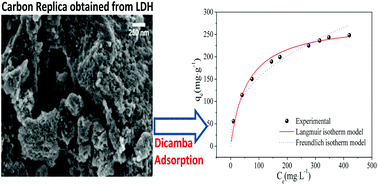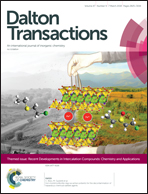Adsorption of Dicamba herbicide onto a carbon replica obtained from a layered double hydroxide
Abstract
In this work, a carbon replica derived from a vinylbenzenesulfonate-intercalated layered double hydroxide (CR-LDH) was applied to remove the Dicamba organochlorine herbicide from aqueous solution. The samples were characterized by several experimental techniques such as X-ray diffraction (XRD), thermogravimetric analysis coupled with differential scanning calorimetry and mass spectrometry (TGA-DSC-MS), X-ray photoelectron spectroscopy (XPS), scanning electron microscopy (SEM), Raman spectroscopy, N2 adsorption/desorption and zeta potential analysis. The CR-LDH sample presents a very high specific surface area (2345 m2 g−1). The adsorption experiment typically followed the Langmuir isotherm model and the adsorption kinetics was best fitted with a pseudo second-order model. The maximum adsorption capacity of Dicamba herbicide onto CR-LDH was 279 mg g−1. CR-LDH presented a higher adsorption capacity than other carbon adsorbent materials reported in the literature.

- This article is part of the themed collection: Recent Developments in Intercalation Compounds: Chemistry and Applications


 Please wait while we load your content...
Please wait while we load your content...